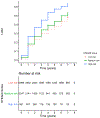Modified STEADI Fall Risk Categories Predict Incident Cognitive Impairment
- PMID: 33565618
- PMCID: PMC8232824
- DOI: 10.1111/jgs.17034
Modified STEADI Fall Risk Categories Predict Incident Cognitive Impairment
Abstract
Background/objectives: It is unknown whether older adults at high risk of falls but without cognitive impairment have higher rates of subsequent cognitive impairment.
Design: This was an analysis of cross-sectional and longitudinal data from National Health and Aging Trends Study (NHATS).
Setting: NHATS, secondary analysis of data from 2011 to 2019.
Participants: Community dwelling adults aged 65 and older without cognitive impairment.
Measurements: Participants were classified at baseline in three categories of fall risk (low, moderate, severe) using a modified algorithm from the Center for Disease Control's STEADI (Stop Elderly Accidents, Deaths, and Injuries) and fall risk from data from the longitudinal NHATS. Impaired global cognition was defined as NHATS-derived impairment in either the Alzheimer's Disease-8 score, immediate/delayed recall, orientation, clock-drawing test, or date/person recall. The primary outcome was the first incident of cognitive impairment in an 8 year follow-up period. Cox-proportional hazard models ascertained time to onset of cognitive impairment (referent = low modified STEADI incidence).
Results: Of the 7,146 participants (57.8% female), the median age category was 75 to 80 years. Prevalence of baseline fall modified STEADI risk categories in participants was low (51.6%), medium (38.5%), and high (9.9%). In our fully adjusted model, the risk of developing cognitive impairment was hazard ratio (HR) 1.18 [95% CI = 1.08, 1.29] in the moderate risk category, and HR 1.74 [95% CI = 1.53, 1.98] in the high-risk category.
Conclusion: Older, cognitively intact adults at high fall risk at baseline had nearly twice the risk of cognitive decline at 8 year follow-up.
Keywords: cognitive decline; dementia; fall; frequent falls.
© 2021 The American Geriatrics Society.
Conflict of interest statement
Figures

Similar articles
-
Frailty Versus Stopping Elderly Accidents, Deaths and Injuries Initiative Fall Risk Score: Ability to Predict Future Falls.J Am Geriatr Soc. 2018 Mar;66(3):577-583. doi: 10.1111/jgs.15275. Epub 2018 Feb 10. J Am Geriatr Soc. 2018. PMID: 29427525 Free PMC article.
-
Risk Factors for Injurious Falls in Older Adults: The Role of Sex and Length of Follow-Up.J Am Geriatr Soc. 2019 Feb;67(2):246-253. doi: 10.1111/jgs.15657. Epub 2018 Nov 29. J Am Geriatr Soc. 2019. PMID: 30496601 Free PMC article.
-
Order of Onset of Physical Frailty and Cognitive Impairment and Risk of Repeated Falls in Community-Dwelling Older Adults.J Am Med Dir Assoc. 2023 Apr;24(4):482-488.e4. doi: 10.1016/j.jamda.2023.01.020. Epub 2023 Feb 25. J Am Med Dir Assoc. 2023. PMID: 36852758 Free PMC article.
-
Cognitive functioning and falls in older people: A systematic review and meta-analysis.Arch Gerontol Geriatr. 2025 Jan;128:105638. doi: 10.1016/j.archger.2024.105638. Epub 2024 Sep 15. Arch Gerontol Geriatr. 2025. PMID: 39340961
-
A Meta-Analysis of Fall Risk in Older Adults With Alzheimer's Disease.J Am Med Dir Assoc. 2024 May;25(5):781-788.e3. doi: 10.1016/j.jamda.2024.01.005. Epub 2024 Feb 17. J Am Med Dir Assoc. 2024. PMID: 38378160 Free PMC article. Review.
References
-
- Ciesielska N, Sokołowski R, Mazur E, Podhorecka M, Polak-Szabela A, Kędziora-Kornatowska K. Is the Montreal Cognitive Assessment (MoCA) test better suited than the Mini-Mental State Examination (MMSE) in mild cognitive impairment (MCI) detection among people aged over 60? Meta-analysis. Psychiatr Pol. October 31 2016;50(5):1039–1052. - PubMed
- Czy test Montreal Cognitive Assessment (MoCA) może być skuteczniejszy od powszechnie stosowanego Mini-Mental State Examination (MMSE) w wykrywaniu łagodnych zaburzeń funkcji poznawczych u osób po 60. roku życia? Metaanaliza. doi:10.12740/pp/45368 - DOI - PubMed
Publication types
MeSH terms
Grants and funding
LinkOut - more resources
Full Text Sources
Other Literature Sources
Medical

